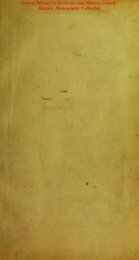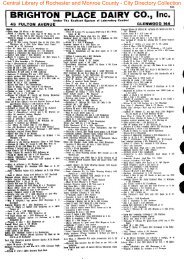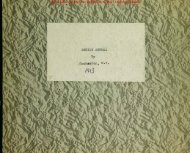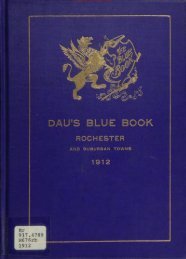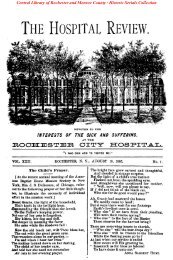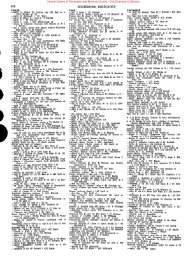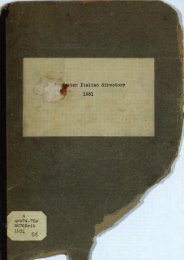The Farm Journal Illustrated Rural Directory of Monroe County, New ...
The Farm Journal Illustrated Rural Directory of Monroe County, New ...
The Farm Journal Illustrated Rural Directory of Monroe County, New ...
Create successful ePaper yourself
Turn your PDF publications into a flip-book with our unique Google optimized e-Paper software.
Central Library <strong>of</strong> Rochester and <strong>Monroe</strong> <strong>County</strong> · <strong>County</strong> Directories Collection<br />
CLASSIFIED BUSINESS DIBECTORY<br />
bine vitriol and strong vinegar, mixed<br />
to the consistency <strong>of</strong> a thin paste. Keep<br />
sheep with fouls away from wet pastures<br />
or stagnant water, and keep feet dry and<br />
clean as possible.<br />
If lame sheep are not doctored, the<br />
fouls soon spread to all parts <strong>of</strong> the<br />
foot, and foot-rot results. This becomes<br />
contagious, and all sheep remaining<br />
where are those with foot-rot will become<br />
lame. <strong>The</strong>re is no need <strong>of</strong> footrot<br />
if the shepherd takes care <strong>of</strong> his<br />
sheep. Treat this the same as the fouls,<br />
being sure to pare away all shell and exposing<br />
the diseased parts. For a<br />
stronger solution than blue vitriol, use<br />
blue vitriol, botyr <strong>of</strong> antimony, and muriatic<br />
acid, equal parts by weight. Use<br />
with care. Paring is the principal thing;<br />
be careful not to cut the toe vein.<br />
Another excellent remedy for foul feet<br />
is one ounce chloride <strong>of</strong> zinc to one<br />
pint <strong>of</strong> water. Apply enough to wet<br />
foul parts once daily after cleaning foot<br />
with dry cloth.<br />
TICKS.—Ticks to sheep are as lice to<br />
hens; they take the life and blood from<br />
the sheep! To kill them, dip your sheep<br />
in some proprietary dip, carbolic preferred,<br />
being careful to follow directions.<br />
SCAB.—Is a strictly contagious disease<br />
<strong>of</strong> the skin, caused by a small mite which<br />
bites the skin. It generally appears on<br />
the back, rump or sides <strong>of</strong> the sheep,<br />
and is first indicated by rubbing and<br />
pulling <strong>of</strong> the wool. <strong>The</strong> disease is very<br />
contagious, common to large flocks and<br />
bands, especially on the western range.<br />
Cure: use some good proprietary dip,<br />
follow directions to the letter, dip your<br />
sheep thoroughly twice, the second dipping<br />
from six to ten days after the first,<br />
not sooner nor later than these limits.<br />
Disinfect all pens thoroughly and keep<br />
sheep from the old pastures at least two<br />
months. Scab is not very common to<br />
eastern sheep owners. Inspect all new<br />
animals at once for scab, as it is <strong>of</strong>ten<br />
introduced by purchasing stock ewes or<br />
rams.<br />
SORE EYES.—Caused by too much wool<br />
over the eyes, and the eyelid rolling into<br />
the eye; also by getting something into<br />
die eye. Shear the wool away from the<br />
eye, and tie the cap <strong>of</strong> wool up <strong>of</strong>f from<br />
the eyes, if necessary; if there is a film<br />
over the eye, better apply a few drops<br />
<strong>of</strong> absolution <strong>of</strong> ten grains <strong>of</strong> bone acid<br />
to the ounce <strong>of</strong> water, put in a pinch <strong>of</strong><br />
powdered burnt alum.<br />
SORE TEATS.—<strong>The</strong> teats on ewes with<br />
lambs sometimes become sore and tender,<br />
so that the lamb can not suck. Rub<br />
twice a day with salted butter.<br />
CAKED UDDER.—Sometimes caused by<br />
weaning and not milking after the lamb<br />
is taken away. Generally occurs in<br />
heavy milkers; also occurs when lamb<br />
is still sucking, in one side <strong>of</strong> the bag<br />
at first. It is accompanied by stiffness<br />
in the hind quarters, the bag is hard, and<br />
in the first stages a thin, watery-like<br />
fluid can be drawn from the teat. Rub<br />
well and carefully, using camphorated<br />
sweet oil; the principal thing is the rub 1<br />
bing; try to s<strong>of</strong>ten the bag and keep<br />
the teat open. Many times the ewe will<br />
lose the use <strong>of</strong> that side <strong>of</strong> her bag<br />
entirely. If she does, send her to market.<br />
Where gait is stiff and udder<br />
caked, give the ewe one dram salicylate<br />
<strong>of</strong> soda three times daily for three or<br />
four days.<br />
CASTING WITHERS.—Thrusting out <strong>of</strong><br />
the womb. It should be washed in a<br />
pint <strong>of</strong> warm water, in which has been<br />
dissolved a teaspoonful <strong>of</strong> powdered<br />
alum, and the womb replaced, and a<br />
stitch taken in the upper part <strong>of</strong> the<br />
opening <strong>of</strong> the vagina. <strong>The</strong> best way<br />
to cure such ewes is to market them or<br />
kill at once if they continue to give<br />
trouble in this respect. After replacing<br />
the womb, keep hind parts <strong>of</strong> animal<br />
quite high by standing in narrow stall<br />
made for the purpose, with floor made<br />
high behind.<br />
GOITER.—Lumps in the throat. Common<br />
to lambs when born; also in young<br />
sheep during the first winter. Some<br />
think the latter is caused by high feeding.<br />
Apply tincture <strong>of</strong> iodine with a<br />
swab, rubbing on enough to color well<br />
the affected portion. Two or three applications,<br />
two to four days apart, should<br />
remove the worst case <strong>of</strong> goiter.<br />
CASTRATING. — Hold as for docking.<br />
Cut <strong>of</strong>f a good sized portion <strong>of</strong> the end<br />
<strong>of</strong> the sac with a sharp knife, push back<br />
the sack from the testicles, grasp the<br />
latter singly, with right hand, and grasp<br />
narrow or upper portion <strong>of</strong> sac firmly<br />
with left hand, and draw out until the<br />
cord breaks. Do not cut the cord, but<br />
break it. When docking and castrating<br />
at the same time, castrate first, then<br />
dock, and release the lamb. <strong>The</strong> whole<br />
operation should not take over one to<br />
two minutes.<br />
379



